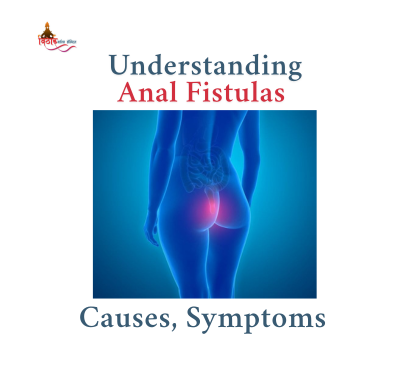An anal fistula is a painful medical condition that occurs when an abnormal tunnel forms between the anal canal and the skin around the anus. It often results from an infection that creates a pus-filled cavity (abscess), which, if not properly treated, develops into a fistula.
Anal fistulas do not heal on their own and require medical intervention, often surgical treatment, to prevent complications like persistent infections or incontinence.
In this blog, we will explore the causes, symptoms, risk factors, and surgical treatments of anal fistulas, helping you understand when to seek medical attention.
What is an Anal Fistula?
An anal fistula is a small tunnel that forms between the end of the bowel (inside the anal canal) and the skin near the anus. This happens when an infection in the anal glands causes an abscess, which fails to heal properly, leading to the formation of a fistula.
Types of Anal Fistulas
Anal fistulas are classified based on their location and severity:
- Intersphincteric Fistula – The most common type; passes between the internal and external sphincter muscles.
- Transsphincteric Fistula – Passes through both sphincter muscles, often forming a U-shaped tract.
- Suprasphincteric Fistula – Starts above the internal sphincter and extends downward.
- Extrasphincteric Fistula – The rarest type; starts high in the rectum and extends to the skin.
What Causes an Anal Fistula?
Anal fistulas develop due to infections in the anal glands that create an abscess. If untreated, the abscess bursts and forms a fistula.
Common Causes Include:
✔️ Anal Abscesses – Infections that do not heal properly can form a fistula.
✔️ Crohn’s Disease – Chronic inflammation increases the risk of anal fistulas.
✔️ Tuberculosis (TB) – TB infections can spread to the anal area, causing fistulas.
✔️ Trauma or Surgery – Injury to the anal region may result in fistula formation.
✔️ Radiation Therapy – Patients undergoing radiation therapy for cancer may develop anal fistulas.
Symptoms of an Anal Fistula
Patients with anal fistulas often experience persistent pain, discomfort, and drainage.
Common Symptoms Include:
✅ Persistent Anal Pain – Especially while sitting, moving, or during bowel movements.
✅ Swelling and Redness – The area around the anus may appear inflamed.
✅ Discharge of Pus or Blood – A fistula may drain foul-smelling pus or blood, leading to irritation.
✅ Recurring Abscesses – Frequent pus-filled swellings in the same area.
✅ Fever and Fatigue – Infection-related fever and body weakness.
🚨 When to See a Doctor?
If you notice pus drainage, severe pain, or fever, seek immediate medical attention.
Diagnosing an Anal Fistula
A proctologist or colorectal surgeon will diagnose an anal fistula through:
- Physical Examination – Checking for an opening near the anus with drainage.
- Digital Rectal Examination (DRE) – Using a gloved finger to assess internal swelling.
- Fistulography (X-ray with Contrast Dye) – Helps locate the fistula’s pathway.
- MRI or CT Scan – Used in complex cases to map the entire fistula tract.
Treatment Options for Anal Fistulas
Anal fistulas rarely heal on their own and usually require surgical intervention. Treatment aims to:
✔️ Remove the fistula tract
✔️ Preserve sphincter muscle function
✔️ Prevent recurrence
1. Fistulotomy (Traditional Surgery)
A fistulotomy is the most common surgical procedure where the fistula tract is cut open and left to heal naturally.
✅ Success Rate: 85–95%
✅ Healing Time: 6–8 weeks
🚨 Risk: May cause incontinence if the sphincter is affected.
2. Seton Placement (For Complex Fistulas)
A seton (a medical thread) is placed inside the fistula to keep it open, allowing drainage and gradual healing.
✅ Used for: Complex fistulas that involve sphincter muscles.
✅ Procedure Time: 15–30 minutes
✅ Healing Time: Several weeks to months
3. LIFT Procedure (Minimally Invasive Option)
LIFT (Ligation of Intersphincteric Fistula Tract) is a modern technique where the fistula tract is tied off and removed without affecting sphincter muscles.
✅ Best for: Deep fistulas
✅ Minimally invasive, preserves continence
✅ Faster recovery than traditional surgery
4. Laser Surgery (FILAC – Fistula Laser Closure)
A laser fiber is inserted into the fistula tract to seal it with heat energy.
✅ Minimally invasive
✅ Lower recurrence rate
✅ Faster recovery (1–2 weeks)
5. Fibrin Glue & Collagen Plug (Non-Surgical Methods)
For mild cases, fibrin glue or collagen plugs can be used to seal the fistula.
✅ No cutting or stitches required
✅ Less pain, quick procedure
🚨 Success rate is lower compared to surgery.
Recovery After Anal Fistula Surgery
Patients can expect:
✔️ Mild pain and swelling for 1–2 weeks
✔️ Daily warm sitz baths for comfort
✔️ High-fiber diet & hydration to prevent constipation
✔️ Antibiotics and painkillers as prescribed
🚨 Avoid heavy lifting and prolonged sitting for a few weeks.
How to Prevent Anal Fistulas?
Although not always preventable, you can reduce the risk by:
✔️ Maintaining good hygiene
✔️ Treating anal infections early
✔️ Eating a high-fiber diet to prevent constipation
✔️ Managing Crohn’s disease or other conditions
Anal fistulas are painful but treatable conditions that require proper medical attention. If you experience persistent anal pain, discharge, or swelling, consult a colorectal specialist for evaluation and treatment.
Timely surgery prevents complications and restores comfort. If you have concerns, seek medical advice today!
FAQ
1. Can an anal fistula heal on its own?
No, anal fistulas do not heal naturally. Medical or surgical treatment is required to prevent infection and recurrence.
2. What is the best surgery for anal fistula?
The best surgery depends on the complexity of the fistula. Fistulotomy is the most common, while LIFT or laser surgery is preferred for deep fistulas.
3. How long does it take to recover from anal fistula surgery?
Recovery depends on the procedure performed. Fistulotomy takes 6–8 weeks, while laser surgery or LIFT heals in 2–4 weeks.

